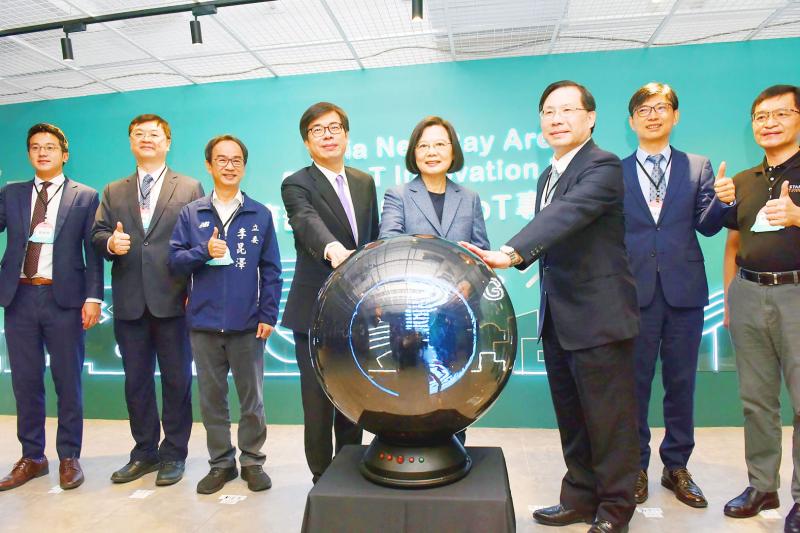The government yesterday inaugurated the program office for a 5G artificial intelligence of things (AIoT) innovation park in Kaohsiung’s Asia New Bay Area (亞洲新灣區).
The 5G AIoT Innovation Park Program Office is to oversee the construction of Taiwan’s most comprehensive 5G and AIoT testing and demonstration facilities, and an innovation park for start-ups.
The five-year, NT$11 billion (US$396.5 million) investment plan, which was announced early this year by the Executive Yuan, involves the Kaohsiung City Government, the Ministry of Economic Affairs, the Ministry of Transportation and Communications, the National Development Council, the National Communications Commission and the Ministry of Culture.

Photo courtesy of the Ministry of Economic Affairs
The government has so far attracted 42 local and foreign start-ups — including InSynerger Technology Co (思納捷科技), Dudoo Ltd (肚肚), Pumpkin Studio (南瓜虛擬科技), Nadi System Corp (杰悉科技) and Uniigym Co (優力勁聯) — to join the innovation park, the Ministry of Economic Affairs said in a statement.
The government hopes to build a complete entrepreneurial environment with ample resources at the park to help start-ups expand their markets and align with international trends, it said.
In addition, several start-up accelerators and local companies, as well as some international corporations, such as Amazon Web Services, Microsoft Corp and Nvidia Corp, have expressed an interest in having a presence at the innovation park, Vice Minister of Economic Affairs Lin Chuan-neng (林全能) said.
The Asia New Bay Area investment plan would also promote music centers, conferences and exhibitions, as well as e-sports and logistics development in Kaohsiung, the Ministry of Economic Affairs said.
President Tsai Ing-wen (蔡英文) was briefed by the city government and several ministries about the investment plan earlier yesterday at the inauguration ceremony.
The program office would play an important role in the government’s efforts to balance development between southern and northern Taiwan, Tsai said.
It is a starting point for Kaohsiung’s digital transformation, and represents a close collaboration between the central and local governments, she said.
Tsai added that she expects the investment plan to help Kaohsiung develop into a new technology center, create more high-quality work opportunities for young people in the south, and lead to a new phase of industrial and economic development in the nation.
At the ceremony, Kaohsiung Mayor Chen Chi-mai (陳其邁) thanked the central government for supporting high-tech development in the Asia New Bay Area through the 5G, AIoT, information technology and digital sectors, and praised the close collaboration between various ministries and the city government that enabled the program office to start operations 10 months after its initiation.
In addition, a newly developed science park in Kaohsiung’s Ciaotou District (橋頭) would soon allow manufacturers to start choosing sites and build factories, Chen said, adding that several international companies would be joining the park.

Taiwan Semiconductor Manufacturing Co (TSMC, 台積電) last week recorded an increase in the number of shareholders to the highest in almost eight months, despite its share price falling 3.38 percent from the previous week, Taiwan Stock Exchange data released on Saturday showed. As of Friday, TSMC had 1.88 million shareholders, the most since the week of April 25 and an increase of 31,870 from the previous week, the data showed. The number of shareholders jumped despite a drop of NT$50 (US$1.59), or 3.38 percent, in TSMC’s share price from a week earlier to NT$1,430, as investors took profits from their earlier gains

In a high-security Shenzhen laboratory, Chinese scientists have built what Washington has spent years trying to prevent: a prototype of a machine capable of producing the cutting-edge semiconductor chips that power artificial intelligence (AI), smartphones and weapons central to Western military dominance, Reuters has learned. Completed early this year and undergoing testing, the prototype fills nearly an entire factory floor. It was built by a team of former engineers from Dutch semiconductor giant ASML who reverse-engineered the company’s extreme ultraviolet lithography (EUV) machines, according to two people with knowledge of the project. EUV machines sit at the heart of a technological Cold

Taiwan’s long-term economic competitiveness will hinge not only on national champions like Taiwan Semiconductor Manufacturing Co. (TSMC, 台積電) but also on the widespread adoption of artificial intelligence (AI) and other emerging technologies, a US-based scholar has said. At a lecture in Taipei on Tuesday, Jeffrey Ding, assistant professor of political science at the George Washington University and author of "Technology and the Rise of Great Powers," argued that historical experience shows that general-purpose technologies (GPTs) — such as electricity, computers and now AI — shape long-term economic advantages through their diffusion across the broader economy. "What really matters is not who pioneers

TAIWAN VALUE CHAIN: Foxtron is to fully own Luxgen following the transaction and it plans to launch a new electric model, the Foxtron Bria, in Taiwan next year Yulon Motor Co (裕隆汽車) yesterday said that its board of directors approved the disposal of its electric vehicle (EV) unit, Luxgen Motor Co (納智捷汽車), to Foxtron Vehicle Technologies Co (鴻華先進) for NT$787.6 million (US$24.98 million). Foxtron, a half-half joint venture between Yulon affiliate Hua-Chuang Automobile Information Technical Center Co (華創車電) and Hon Hai Precision Industry Co (鴻海精密), expects to wrap up the deal in the first quarter of next year. Foxtron would fully own Luxgen following the transaction, including five car distributing companies, outlets and all employees. The deal is subject to the approval of the Fair Trade Commission, Foxtron said. “Foxtron will be